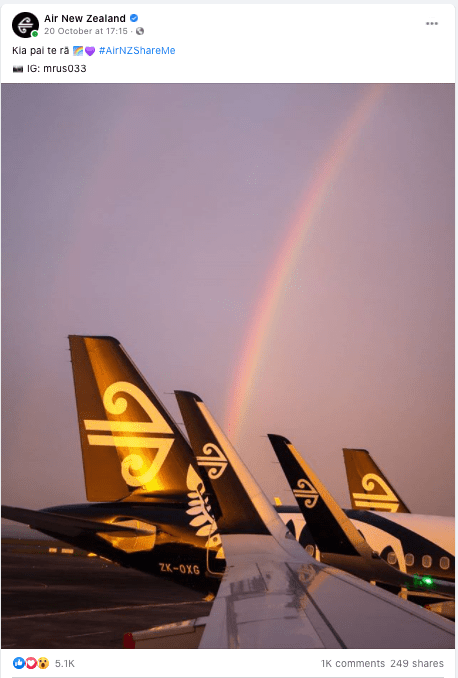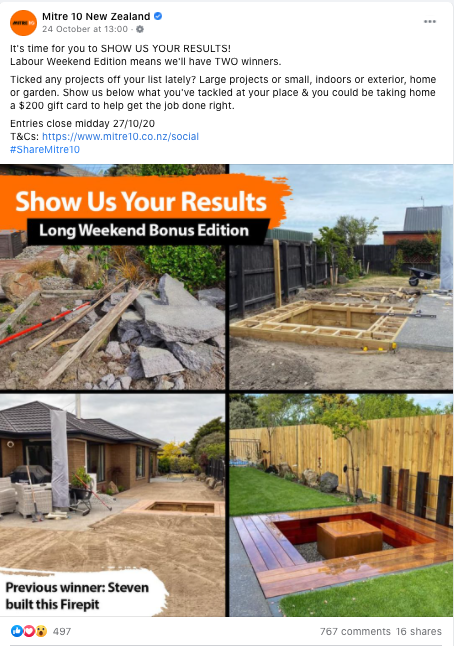The big news of October wasn’t related to the commercial brands on the scoreboard at all – but may well have impacted what people were doing on social media. It will not surprise you to hear that the election was New Zealand’s priority in October. Topic analysis on Zavy Radar shows Kiwis were having optimistic conversations around Labour, Jacinda Ardern, Election, Vote and (slightly less optimistic) conversations about Judith Collins. Almost all of the articles or stories that had Kiwis talking most in October 2020 were about Labour. And unlike last month, when Whittaker’s swept the board to have the most popular post of the month, Labour took out top content too.
What does this mean for the scoreboard?
The brands that stay in the top five most consistently all have a healthy focus on brand marketing, helping them rise above the news-cycle. Although we’re seeing political themes enter comments.
Air New Zealand earned one of the top posts of the month last week with an on-brand photo of their planes against a rainbow, with the caption, “Kia pai te rā”. So far, so uncontroversial.
But one comment, and the reactions to it, perhaps indicated that people were feeling particularly politically charged. The comment: “Air nz I think you’re great, but please use English. Most people don’t understand whatever language you are using.” sparked 584 reactions and 479 replies, asking the commenter to “take your xenophobia elsewhere please.”

The volume of comments shutting down racism is interesting. We’re clearly proud of being open and accepting, and the election may have brought these issues front of mind. With the US election dominating newsfeeds, commenters may have felt extra-protective – and proud – of their values.
Fast food dominates YouTube
You may be surprised to see that Burger King has jumped 18 points to take the #7 spot on the scoreboard, flanked by KFC and Pizza Hut. Toggling the Scoreboard across channels shows that these brands are making big gains on YouTube.
Much like TV, YouTube is more of a place where brands put their message in front of people – but don’t expect engagement. It’s very much a reach play, as opposed to social channels like Facebook and Instagram that use reach but also look to engage with audiences.
For these brands, the key to success will be complementing reach activity on YouTube with posts on other platforms to start conversations with their customers.
Mitre 10: Building a strong social presence
There is one outlier on the YouTube Scoreboard: Mitre 10, with the number one spot. Unlike the other Scoreboard brands making a play on YouTube, with high views and low subscribers, Mitre 10 has 209,000 subscribers – and high views.

Their channel follows a clear content strategy: how-to videos, videos for kids, as well as docu-style videos following DIY journeys. This contrasts with the brand’s Instagram, filled with interiors #inspo and a smattering of DIY, and Facebook, with engagement activities and (very popular) competitions.
This speaks to the special sauce that’s helping Mitre 10 keep their ranking on the scoreboard: a channel focused content strategy that shares the right messages with the right segments of their audience, on the right platforms. The people they’re talking to on YouTube are unlikely to be the same people on Instagram – and if they are, they’re probably looking for different content there.
Competitions…again
As ever, the Scoreboard shows the majority of Facebook posts from brands in the scoreboard are competitions. And while competitions are shaping up to be New Zealand’s most beloved form of engagement, it doesn’t make for exciting scoreboard write ups. Nor does it develop meaningful relationships with customers. Allow us to quote ourselves:
For immediate engagement, competition posts are extremely efficient at triggering a frenzy of likes, reactions and comments. However, due to the nature of these types of posts it is surface level engagement.
Competition posts do not typically generate a meaningful or lasting exchange with an individual, which is due to competitions essentially ‘buying’ engagement by soliciting it, as opposed to earning it.
If you want to do competitions right, make sure you’re not over-doing them, and that they’re connected to a cultural moment that makes them feel a bit more relevant to the times. To stand out from the crowd, make them participatory – more than just tagging a friend in the comments.
For example, consider how your competition mechanic could encourage people to share photos of themselves using your product or service. This not only gives those participating a reason to buy, it also creates a herding effect, showing non-participants the popularity of the stuff you sell or the behaviour your organisation is seeking people to adopt – e.g. Mitre 10’s letterbox make-overs and home-made KFC.
Ocean-Spray’s recent viral fluke offers a clue to how leveraging a cultural moment, combined with participation can create engaging competitions. When the Ocean Spray Guy TikTok went viral, in order to participate in the meme, people had to buy and share a video of themselves with the product. Ocean Spray was a happy accident, but competitions can be designed like this intentionally – find the cultural moment appropriate for your brand and find a compelling reason for followers to truly participate. That way, your competition will be more than social stats – they’ll be memorable, fun, and will go a long way to building relationships with your audience.
Want to know what your brand’s social score is? Click here to get started.
The post Zavy + StopPress Social Scoreboard: What happened in October? appeared first on stoppress.co.nz.
More Stories
Publicis Media Exchange ANZ appoints Anthony Ellis as CEO
Creator Jayde Powell Has the Tea on Finding a Safe Space in Social Media
Sex.life’s quickie to 1 million downloads